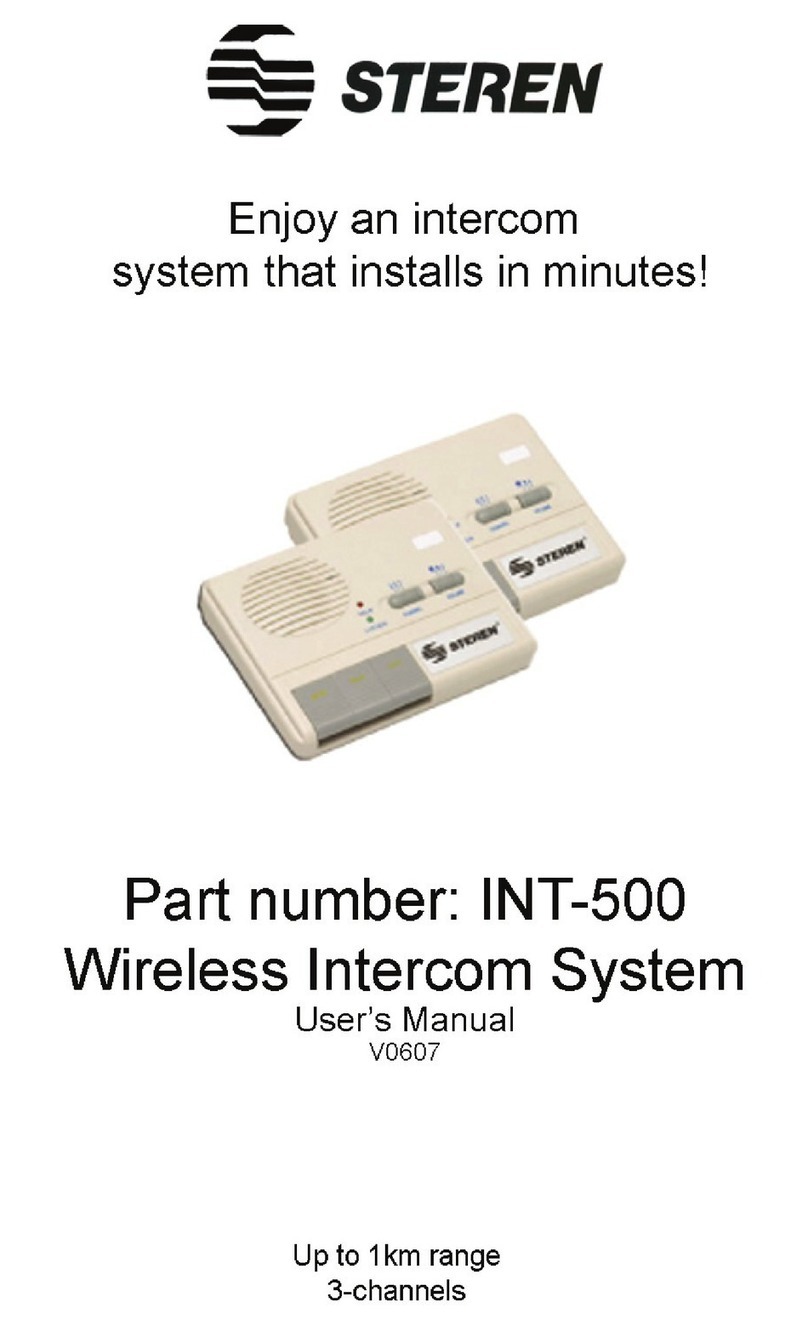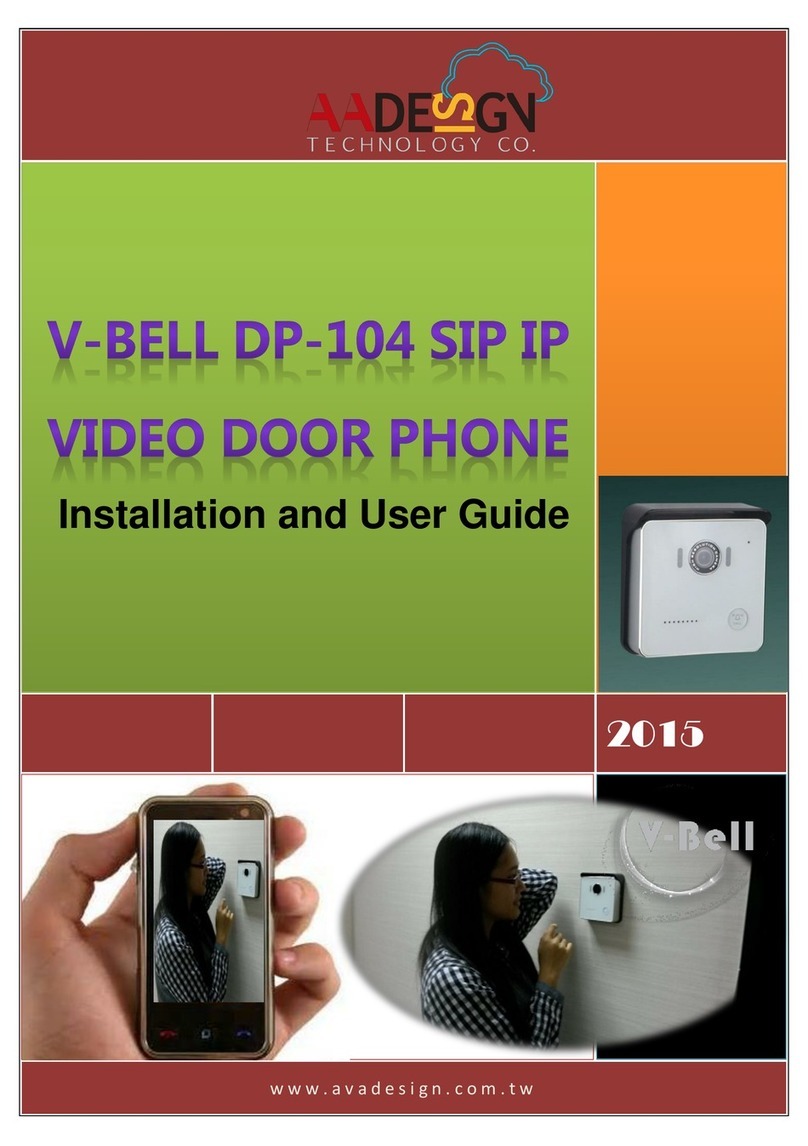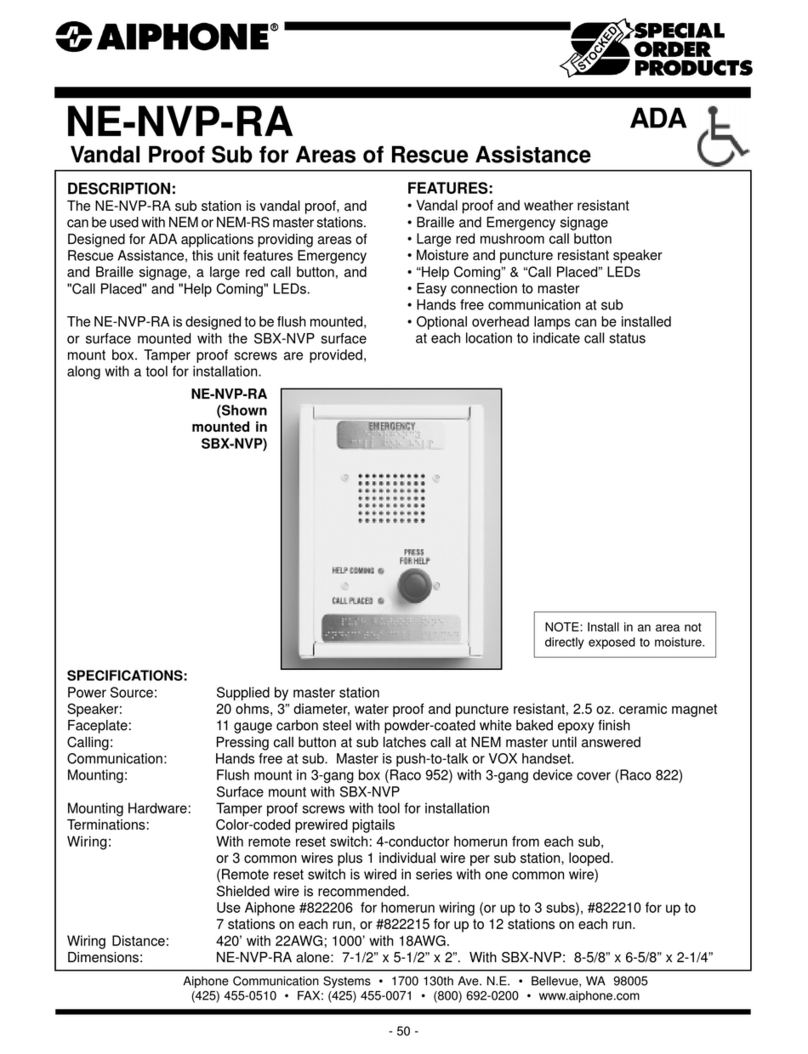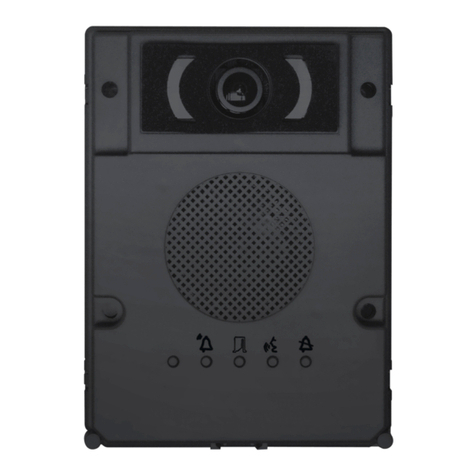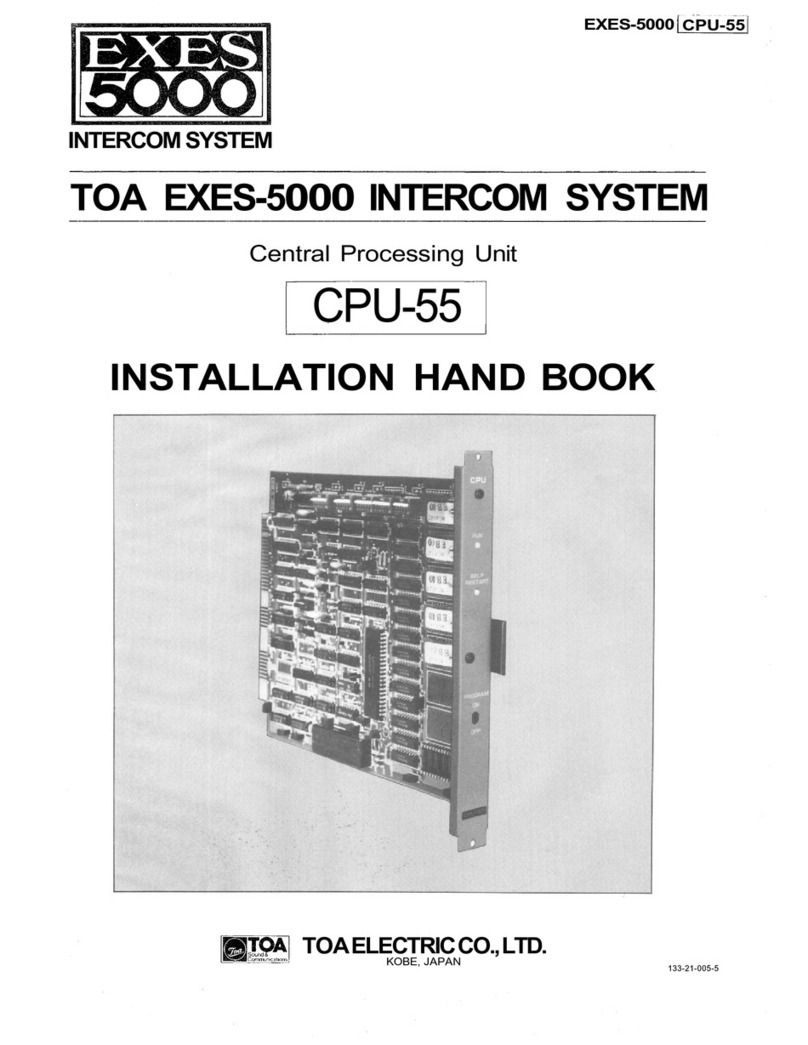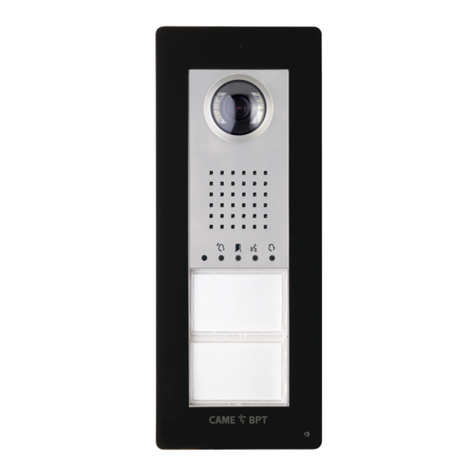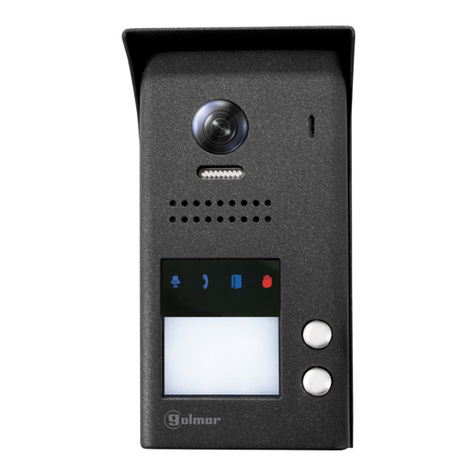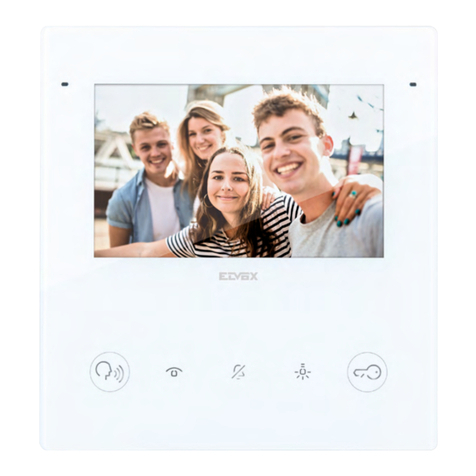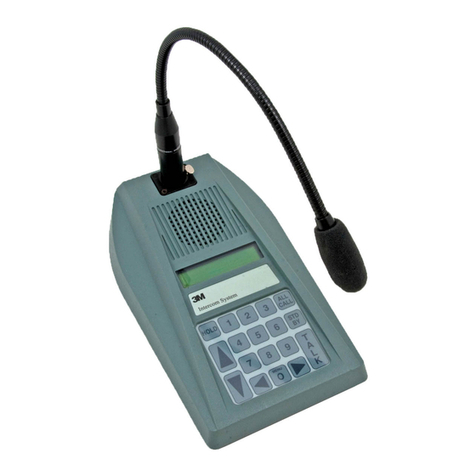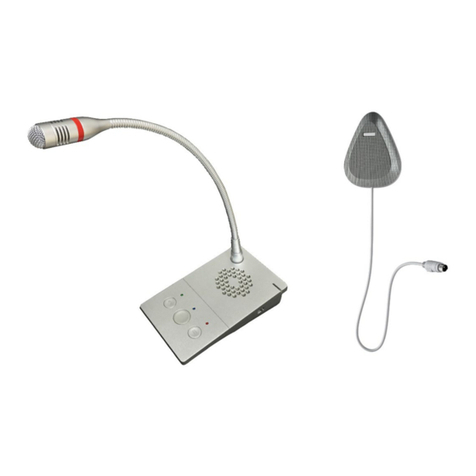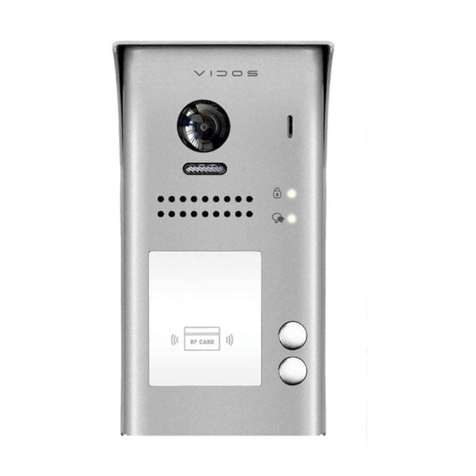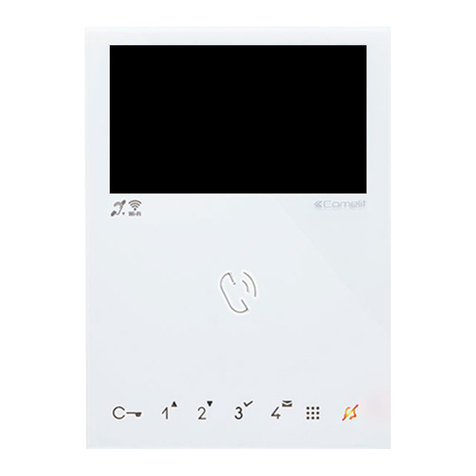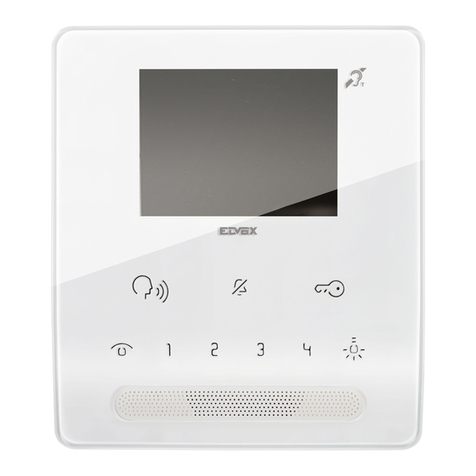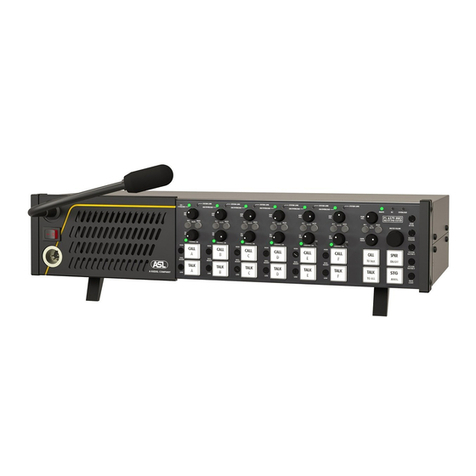Siedle SSS SIEDLE Technical manual

Planning and
System Manual
Access Professional
Issue 2017

2
Contents
1 Safety remarks 4
2 System description
Access in general 6
Fields of application 6
Performance features 6
System overview 7
3 System structure, conductor
material and range
General planning information 8
Planning areas 8
Supply limits ATLC/NG670-… 9
Permitted conductor material 9
Network LAN 10
Cabling structure/areas 10
Power over Ethernet (PoE) 10
Network characteristics 10
Cabling for indoor devices 11
Cameras 12
Pick-up range of the camera 13
Location of the video camera 13
4 System components
Overview 18
Door stations
(outdoor/indoor area) 20
Access cameras 24
External cameras 25
Indoor stations (audio/video) 26
Accessory 28
Distribution components –
Door controller 29
Distribution components –
Active/passive system expansion 30
Distribution components –
Line rectiers 31
Distribution components –
Transformers 32
Space requirements in distribu-
tion boards/IT cabinets (19 inch) 33
Access server variants 34
Minimum requirements – Server
hardware / Virtual machine 36
System conditions
Access Professional 37
Additional requirements
imposed on virtualization 37
Network security 38
Client-Software 38
App 39
Software integration for
non-Siedle systems 39
Upgrade (server) 39
Access licences 40
Microsoft licences (CAL) 43
5 Function overview 44
6 Conguration –
Access System
Models 48
Server administration –
device parameters 51
Button functions 53
7 Access control through the
Vario bus
Ranges in the Vario bus 60
Distribution components –
Transformers 62
Modules 63
Distribution components –
Server/controller 64
8 Access circuit diagrams
Overview 66
Switching outputs/inputs 68
8.1 Siedle Vario 70
8.2 Access custom-t door
loudspeaker 98
8.3 Siedle Classic 104
8.4 Siedle Steel 114
8.5 Camera connection 126
8.6 Storey call button 130
9 Commissioning and operation
Commissioning 132
Commissioning requirements 132
Commissioning instruction 132
Recommendation 133
Operating manual 133
Updates and maintenance 133
Maintenance contract 133

3
Remarks
This document serves as a guide
for the planning and technical
implementation of the Siedle Access
system. It is designed to provide an
overview of the key points that need
to be observed.
This document supplements and is
supplemented by the Access server
commissioning instructions.
To supplement this system manual,
you will nd the latest edition in the
download area of our website on
www.siedle.com
For complex systems or special
requirements, the technical consult-
ants in Project Sales will be pleased to
advise you.
(For detailed information, see
page153)
We accept no liability for modi-
cations, mistakes or printing
errors.
Modications / additions, mistakes
or printing errors do not form
grounds for any claim to compensa-
tion for damages.
10 Servicing
Service requirement 134
Warranty 134
Exchanging devices 134
Exchanging ATLM/ATLE670-… 134
Exchanging a defective server
AS670-…/ASH670-… 134
Update process 134
Start process 134
Initial commissioning/Login 135
Registration at the administrator
user interface 135
LED displays 136
Terminal connections and meas-
ured values 138
11 Glossary 140
12 Index
Access components 150
Access topics 151
13 Siedle service
Customer support and cus-
tomer advice/Siedle centres 152
After-sales service 153

4
1 Safety remarks
Electrical voltage
Mounting, installation and servicing
work on electrical devices may only
be performed by a suitably qualied
electrician.
Failure to observe this regulation
could result in the risk of serious
damage to health or fatal injury due
to electric shocks.
Devices with 230V connection
In accordance with DIN VDE0100
part410, section 411.1.3 attention
must be paid to ensuring a safe sepa-
ration between system lines and the
mains voltage; i.e. system and mains
cores must not be permitted to touch!
The system line cable (extra-low safety
voltage) must be stripped back by the
minimum possible.
Electrostatic charging
As a result of electrostatic charging,
direct contact with the circuit board
can result in destruction of the
device. Direct contact with the circuit
board must therefore be avoided.
• When working at the device,
observe the remarks relating to
mains cut-off.
• Observe the DIN EN60065
standard! When establishing the
electronic connection, observe
the requirements of VDE0805 or
EN60950.
• The building installation must
include an all-pole mains switch
with a contact separation of at least
3mm.
• Ensure maximum fusing of 16A
for the mains connection in the
building installation.
• When planning large-scale
(complex) systems, the distributor
space required for the switch panel
mounting devices must be taken
into consideration in the distributor
planning process.
• No external voltages >30 V AC/DC
may be applied to system users.
Electrical distribution boards and
IT cabinet systems
Please make sufcient provisions in
the electrical distribution boards/IT
cabinet system for later expansion,
changes or subsequent disassembly
(service/maintenance).
Plan the electrical distribution board/
the IT cabinet system so that the
heat generated by all installed com-
ponents is adequately dissipated and
cannot impair any functions or cause
damage to the components or infra-
structure at the installation site.
During planning, take the applicable
legal provisions, standards, directives
and safety instructions for the opera-
tion/installation site into account.
All system components which are
designed for/suitable for installation
in an electrical distribution board or
in an IT cabinet system/housing may
only be installed in the permitted
installation position according to the
enclosed product information.
If system components are operated
in improper installation positions or
with improper operating parameters
(e.g. excessive ambient tempera-
ture), this will render their warranty
rights void in the event of service.

5
Legal notice
Photographs of individuals taken
without their knowledge may not be
published or stored in publicly acces-
sible video memory facilities.
Individuals who have been photo-
graphed without their knowledge
are entitled to request that pictures
be deleted based on the right of
persons to their own likeness. Never
store pictures of persons you do
not know in social networks or
send them by email to others/public
groups. This will infringe their per-
sonal rights.
If stored images are used as part of
private / criminal law proceedings or
in a police investigation, this requires
prior clarication with a lawyer or
the responsible police authority.
Photographs of individuals taken
without their knowledge may not be
published or stored in publicly acces-
sible video memory facilities.
Individuals who have been photo-
graphed without their knowledge
are entitled to request that pictures
be deleted based on the right of
persons to their own likeness. Never
store pictures of persons you do
not know in social networks or
send them by email to others/public
groups. This will infringe their per-
sonal rights.
If stored images are used as part of
private / criminal law proceedings or
in a police investigation, this requires
prior clarication with a lawyer or
the responsible police authority.
The legally admissible operation and
installation of this device and all
its system components (hardware
and software) are the responsibility
of the user and not of the device
manufacturer.
Protect your network!
Only use up-to-date components
and terminals in the network in
line with the latest state of the art.
Regularly update the operating sys-
tems of all components and termi-
nals. Exchange obsolete components
and terminals for up-to-date models.
Use professional protective software
(antivirus, rewall, …) in all termi-
nals. Issue secure passwords. Secure
your network with the highest secu-
rity standards available in the net-
work. Protect your network against
unauthorized attack from inside and
outside.
Protect your property!
The SiedleApp can be used from
any location as a door release! Keep
smartphones/tablets on which the
SiedleApp is activated safe from
theft. Protect these devices against
unauthorized usage with a code/
password/ngerprint. Always use the
latest protection mechanisms avail-
able for your smartphone/tablet.

6
Access in general
Siedle Access is a server-based IP
system for building communication.
It offers the whole breadth of Siedle
communication system functionality,
from the speech or video connec-
tion through concierge functionality
to complex switching and control
functions. Access works in its own
IP network.
Central management on the Access
server permits conguration and
administration both over the web
browser and remotely. In addition,
it facilitates system upgrading by
adding and exchanging devices
or licence models (e.g. function
licences, licences for the use of
external makes such as VoIP tel-
ephones).
The system utilizes the network
protocols TCP/IP and UDP, as well
as SIP for internet telephony (VoIP),
extended to include an access-
specic data protocol. The audio
encoding standard (G.711) and
video encoding standard (H.264)
guarantee high picture and tone
quality with minimal network
loading.
Fields of application
Projects with
• a large number of users (door
stations and/or indoor devices) and
long distances
• stringent demands on audio and
video transmission
• several (also geographically) sepa-
rate building sections
• concierge and surveillance func-
tions
• heterogeneous utilization (private
and commercial mixed use)
• fundamental requirement for
structured cabling and IP technology
2 System description
Performance features
Access offers
• Simple planning and installation in
conformity with standards
• PC-based one-man commissioning
• Use of door stations, indoor sta-
tions, software clients or apps
• Up to 320 users and 25 parallel
video and speech channels (full-
duplex voice connections) per Access
server
• Worldwide accessibility with secure
door call via Siedle app on iPhone
or iPad
• An efcient PC-based concierge
workstation with video surveillance
function
• Server for central system manage-
ment and update function
• Indoor devices that are supplied via
PoE (Power over Ethernet) according
to IEEE802.3af
• Extensive audio/video communica-
tion, control and security functions
in and outside the Access system
• Connection of different commu-
nication and control platforms (VoIP,
KNX, etc.)
• System can be linked to public net-
work telephony and telephone sys-
tems conforming to the SIP standard
• Connection of selected third-party
hardware (VoIP TC systems, VoIP
telephone, IP cameras (only for app),
KNX gateways)
• Integration of SIP audio, SIP video
and a/b telephones
• Integration of external cameras
• Intercom functionality
• Function extensions via optionally
available licences
• Call rerouting, call forwarding and
call follow-me function
• Call differentiation in terminals
• Door call via call display or code
lock keypad
• Storey door loudspeaker (with
and without video) and storey door
release
• Display of messages, statuses, or
arriving calls in plain text on devices
with displays
• Scan mode for connected cameras
• Optional group formation (e.g. for
announcements)
• Call storage facility with call list
and video memory
• Polyphonic ringtones
Remarks
From Access V3.1.0, the inte-
gration and operation of a
building automation server (JUNG
FacilityPilotServer) is possible using
the Access Video Panel. Please
note that the building automation
server (JUNGFacilityPilotServer) is
not a constituent part of the Siedle
Access system. Advisory services and
the sale of hardware and licences
take place exclusively through
ALBRECHTJUNGGmbH&Co.KG.

7
ATLC/NG 670
ASHT
10:10
12 1 20.05.2013
Start08:00|16.12.2014
AVP
AHTV AHF AHFV
Router
Internet
Internet
Internet
iPhone
iPad
iPad
iPhone
Router
Internet
ASHT
ASC
iPad
iPhone
Public mobil network
Public WLAN
Local network
Local telephone networkLocal Access network
Door station
Access server
Switch
Switch
SIP telephone SIP telephone SIP telephone SIP telephone SIP telephone
SIP telephone
system
Door release
WLAN
WLAN
Access gateway
Switch Customer server
(e.g. mail server)
3G / 4G
System overview

8
3 System structure, conductor material and range
General planning information
The basis for planning an Access
system is an IP network congured
in accordance with specications
for creating structured cabling (as
described under Network cabling).
The purpose of the Access security
concept is to ensure that network
cabling terminates not outside the
door but with the ATLC/NG670-…
Consequently, the door connection
(as described under cabling in the
door area) is not a constituent part
of the IP network.
For positioning of the Access devices
and network components, it is advis-
able to provide a construction plan.
This should take into consideration
the length restrictions of the con-
nection types such as copper and
optical bres.
The space requirement of network
components and Siedle devices
must be determined and taken into
consideration. Siedle recommends
drawing up a schematic drawing of
the network structure and the used
Siedle devices.
ATLC/NG 670-
…A
TLC/NG 670-…
(+ NG 602-…)
max. 10 m
Door station
Camera
Door area
Network LAN
Range depends on the
installed conductor material.
Network LAN
Door release (Tö)
Planning areas
Generally speaking, a distinction is
drawn between the door area and
the protected local area network
(LAN).
Door area
The installation for the door station
is referred to as the door area. If cor-
rectly installed, this area is protected
from unauthorized access. From the
outside, it is not possible to access
the network.
Logical and self-explanatory names
should be assigned to the various
devices, for example FL1AP5 for 1st
oor, apartment 5. All cable seg-
ments between active components
should be listed in an index showing
their name, cable length and cable
type.
In order to permit correctly con-
trolled server shutdown, we recom-
mend including a UPS (uninter-
ruptible power supply) unit in the
planning.
Cabling in the door area
The IP network terminates with the
ATLC/NG670-… To protect against
unauthorized access, the ATLC/
NG670-… must be accommodated
without fail inside the building.
The cabling from the ATLC/
NG670-… to the door station is
executed in the conventional way.
Every door station/independent
camera is installed in the system
with its own ATLC/NG670-…
The cabling between the door
release and ATLC/NG670-… should
be tamper-proof with a separate line
(direct laying).
If an external camera is used,
the maximum distance between
AIVS670-… and the camera is
10m. The AIVS670-… requires a
video input signal of 1Vss.
The following conductor materials
with suitable maximum ranges have
been ofcially approved for wiring
between ATLC/NG670-… and the
door station:

9
Permitted conductor material
Cable type Diameter Maximum range
Telecommunications installation cable
(Pair-twisted)
J-Y(St)Y… dia. 0.8 mm 200m
J-Y(St)Y… dia. 0.6 mm 100m
Telecommunications outdoor cable
(Quad-twisted)
A-2Y(L)2Y… dia. 0.8 mm 200m
A-2Y(L)2Y… dia. 0.6 mm 100m
Network cable
(Pair-twisted)
Cat.5AWG22… dia. 0.644 mm 120 m
Cat.5AWG23… dia. 0.573 mm 90m
Cat.5AWG24… dia. 0.511 mm 80m
Cat.5AWG26… dia. 0.405 mm 50m
Terminals Cable type – Pair-twisted Cable type – Quad-twisted
ATLC/NG 670-0 Core Twin core Location Core Twin core Bundle
S1 a 1 1 a1
1
S2 b b
S3 a 2 1 a2
S4 b b
D1 a 3 1 a3
2
D2 b b
V1 a 4 1 a4
V2 b b
Depending on the cable type, pair-
twisted or quad-twisted, we rec-
ommend the following connection
methods for the cabling between the
door station and ATLC/NG670-0:
Supply limits ATLC/NG670-…
Siedle Vario Video door stations Audio door stations
Standard with
COM611-…
with
DRM612-…
Standard with
COM611-…
with
DRM612-…
ACM67x-… 111---
ATLM670-… 111111
COM611-… - 1--1-
DRM612-… - - 1--1
BTM650-… 10 1 1 26 12 12
Siedle Classic/Steel
ACM67x-… 111---
CATLE/SATLM670-… 111111
COM611-… - 1--1-
DRM612-… - - 1--1
Call buttons 20 1160 30 30

10
Network LAN
The requirement for integration of
an Access system is a network infra-
structure created in accordance with
the stipulations for generic cabling
(from Category5).
Rules for generic cabling are set out
in various standards:
• DIN 50173-1 General requirements
For individual building types, the fol-
lowing standards apply in addition:
• DIN 50173-2 (ISO/IEC 11801) for
ofce buildings
• DIN 50173-3 (ISO/IEC 24702) for
industrially used locations
• DIN 50173-4 (ISO/IEC 15018) for
apartments
Internationally, the ISO/IEC standards
apply.
Cabling structure/areas
The cabling is broken down into 3
areas.
Primary area
• Fibre optic cables
• Cabling between individual
buildings and/or within buildings
between several main building dis-
tributors.
• In the case of copper wire con-
nections, adequate equipotential
bonding must be guaranteed.
Secondary area
• Fibre optic cables
• The storeys are networked by
means of storey distributors. Both
bre optic and copper connections
can be used. This is dependent upon
the switches used and their distance
from the main distributor/switch.
Tertiary area
• Twisted pair for xed installation
plus patch cable for cabling from
the network junction box to the
terminal.
ATLC/NG 670
Server
Switch
Door station
Primary area
Tertiary area
Secondary area
Door release (Tö)
3 System structure, conductor material and range
Network characteristics
Access system
• Maximum of 50 ms delay in one
direction (one way delay)
• Maximum of 100 ms total delay
• Packet loss < 1%
• Maximum of 20 ms jitter
Power over Ethernet (PoE)
The supply for the indoor stations
must be ensured by the customer
via PoE. Depending on the network
infrastructure, the decentral PoE
supply of individual devices can take
place with PoE injectors, and the
central PoE supply of several devices
can take place with PoE-capable
routers/switches.
Routers/switches used must be PoE-
capable according to IEEE802.3af.

11
Cabling for indoor devices
All indoor devices are always con-
nected via an RJ45 8/8 (or RJ45
socket modules 8(8)) network
socket. This is divided into two
sockets.
The left-hand socket is reserved for
the network (LAN area). The right-
hand socket is independent of the
network and is used for connecting
other control elements permitting
additional uses.
Supplementary functions such as a
storey call button are also connected
via the RJ45 network socket (right-
hand socket/side) or the RJ45 socket
modules 8(8).
The range between ERT and the
indoor device is max. 50m (Cat5
AWG22).
The Access indoor devices can be
installed without problems using
standard RJ45 ush mounting net-
work junction boxes.
In this case, simply install the net-
work junction box without the frame
and panel. The Siedle indoor device
can be mounted above the junction
box and connected to the network
with a plug-in connector.
If there is no ush mounted network
socket at the required mounting
height due to circumstances on site,
the indoor call station can be surface
mounted with the AZA870-… In
this case, the connection from the
indoor call station to the network is
established using a patch cable (not
provided).
If the indoor call station is intended
for use as a table-top unit, the
device can be converted using the
AZTV870-… with 3metre long con-
necting cable.
165 cm
Eye level
Junction box
RJ45
Installation with patch cable
150 cm
165 cm
Eye level
Junction box
RJ45
Installation on
flush mounted junctio box
Ideally, an RJ45 ush mounted junc-
tion box should be positioned at
the mounting height for the indoor
device (display height less 15 cm).
Mounting with Access surface
mounting accessory AZA870-… and
patch cable provided on site.

12
3 System structure, conductor material and range
Cameras
External cameras
Audio door station with external
analogue camera: For the external
camera, an AIVS670-… and a
matching separate power supply
(e.g. NG602…) is required.
Separately operated external ana-
logue camera: One AIVS670-… and
one ATLC/NG670-… are required
for each external analogue camera.
25x2
3x2
2Tö
AIVS 670
ATLC/NG 670-…
NG 602-…
Door station
Camera
LAN
24x23x23x2
22
AIVS 670 AIVS 670
ATLC/NG 670-…
ATLC/NG 670-…
(NG 602-…)
ATLC/NG 670-…
(NG 602-…)
Tö
Door station
Camera 1 Camera 2
LAN
If the camera used cannot be oper-
ated with 48VDC, an additional
power supply (e.g. NG602-…) must
be selected.
The camera is connected to the
ATLC via the AIVS.
The camera is connected to the
ATLC via the AIVS.

13
General
Video cameras operating with the
Vario door loudspeaker or exter-
nally in the background provide an
unobtrusive method of surveillance
in the entrance area. Call, speech
and door release operation of the
door station. The visitor appears on
screen at one or more of the video
call stations.
Possible applications include single
and multiple family homes, private/
commercial premises, practices and
surgeries, administrative buildings
etc.
Other video components for special
applications can be combined with
our devices on request.
Location of the video camera
Selection of the most suitable
camera and its location is decisive
to ensure good picture quality.
The camera must not be directed
towards:
• direct backlight
• direct sunlight
• very bright image backgrounds
• highly reective walls opposite the
camera
• lamps or direct light sources
Pick-up range of the camera
Diagram showing the pick-up range
of external camera CE600-… with
image pick-up chip 1/3".
If the range of a camera module is
not sufcient, external cameras such
as the CE600-… or CE950-… can
be used.
Object distance in m (h)
Object width in m (a)
12.00
10.00
8.00
6.00
4.00
2.00
0.00
3.8 mm
5.0 mm
9.5 mm

14
Diagram showing the pick-up range
of external camera CE950-… with
image pick-up chip 1/4".
Object distance in m (h)
Object width in m (a)
3.8 mm
5.0 mm
8.0 mm
45.6 mm
12.00
10.00
8.00
6.00
4.00
2.00
0.00
Diagram pickup range
Camera ACM670-… with image
pick-up chip 1/3".
Pick-up angle of the camera module
ACM670-…
The adjustment range of the
ACM670-… is indicated by shading.
Object distance in m (h)
Object width in m (a)
12.00
10.00
8.00
6.00
4.00
2.00
0.00
ACM 670 2.9 mm
50 cm
86 cm
106 cm
160 cm
214 cm
appr.
60°
113 cm
50 cm
appr. 80°
3 System structure, conductor material and range
Pick-up range of the camera

15
The picture excerpt visible on the
display is mechanically set on the
ACM670-… camera by max. 30°.
Diagram pickup range
Camera ACM673-… with image
pick-up chip 1/3".
Pick-up angle of the camera module
ACM 673-…
50 cm
114 cm103 cm
217 cm
160 cm
ca. 100°
246810 12
Object distance in m (h)
Object width in m (a)
12.00
10.00
8.00
6.00
4.00
2.00
0.00
2.1 mm
205 cm
50 cm
appr. 130°

16
The ACM 673-… camera transmits
the entire recorded video image.
Diagram pickup range
Camera ACM678-… with image
pick-up chip 1/3".
Pick-up angle of the camera module
ACM 678-… in full screen mode.
ca. 135°
160 cm
50 cm
234 cm
43 cm
277 cm
246810 12
12.00
10.00
8.00
6.00
4.00
2.00
0.00
1.4 mm
Object distance in m
Object width in
m
appr. 165°
760 cm
50 cm
3 System structure, conductor material and range
Pick-up range of the camera

17
Select the picture excerpt based on
the existing mounting situation.
The pick-up angle of camera module
ACM678-… can be adjusted
depending on the mounting situ-
ation.
Required picture excerpt from the
camera view (1to9) or full screen
(0).
Picture excerpt (1–3) top camera
alignment
Picture excerpt (4–6) central camera
alignment
Picture excerpt (7–9) bottom camera
alignment
70° 70° 70°
160 cm
160 cm
160 cm
50 cm 50 cm 50 cm
277 cm
125 cm
195 cm
124 cm
43 cm
167 cm
70 cm
124 cm
123
456
789

18
4 System components
Overview
* Can also be used for customer’s
existing door stations/letterbox sys-
tems.
Door stations
(outdoor/indoor area)
(Possible designs:
Vario/Classic/Steel)
• ACM 670-…
Access camera 80 for Siedle Vario
• ACM 673-…
Access camera 130 for Siedle Vario
• ACM 678-…
Access camera 180 for Siedle Vario
• ATLE 670-… *
Access custom-t door loudspeaker
incl. Bus call button matrix
• ATLM 670-…
Access door loudspeaker module
• BRMA 050-… *
Bus call button matrix
• BTM650-01 to -04
Bus call button module
• COM 611-…
Code lock module
• DRM 612-…
Display call module
• ELM 611-…
Electronic-key reading module
• FPM 611-…
Fingerprint module
• PME…
Mail notication system
(Classic/Steel)
• TÖ 61x-…
Door release (DIN left or right)
• VTMC 640-…
Flush-mounted colour camera
External cameras/
Surface-mounted components
• AIVS 670-…
Access Interface analog-video
standard
• CE 600-…
External colour CCD video camera
for external mounting
• CE 950-…
External colour CCD video camera
for external mounting
Indoor stations (audio/video)
• AHF 870-…
Access handsfree telephone
• AHFV 870-…
Access video handsfree telephone
• AHT 870-…
Access in-house telephone
• AHTV 870-…
Access video in-house telephone
• AVP 870-…
Access video panel
Upgrade (audio indoor station)
• AUV870-…
Access for video upgrade
Accessory
• AZA 870-…
Access surface-mount accessory
• AZIO 870-…
Access input/output accessory
• AZTV 870-…
Access table-top accessory
• AZTVP 870-…
Access table-top accessory
• ZRE 600-…
19inch rack mounting accessory
Distribution components
• ANG 600-…
Access line rectier
• ATLC/NG 670-…
Access door loudspeaker controller
with line rectier
• ATLCE 670-…
Access door loudspeaker controller
extension
• AVA 670-…
Access video decoupler
• ECE 602-…
Entrance controller extension
• EC 602-…
Entrance controller
• NG 602-…
Line rectier
• TCIP 603-…
Door controller IP
• TCIP SRV 603-…
Door controller IP server
• VNG 602-…
Video line rectier
• TR 602-…
Transformer
• TR 603-…
Transformer
• ZWA 640-…
Western socket accessory

19
Client-Software
• ASC 170-…
Access Software Concierge
• ASHT 170-…
Access Software In-house telephone
App
• Siedle app for Access
Software integration for
non-Siedle systems
• ASM 170-…
Access software module
Access user licence packages
(Server operation)
• APR 670-0 10 Access Professional
• APR 670-0 20 Access Professional
• APR 670-0 40 Access Professional
• APR 670-0 80 Access Professional
• APR 670-0 160 Access Professional
• APR 670-0 320 Access Professional
Optional Access application
licences (Models)
• ALFA 270-…
Access licence for external audio
device
• ALFS 270-…
Access licence for external smart-
phone
• ALFT 270-…
Access licence for external tablet
• ALFV 270-…
Access licence for external video
device
• ALKNX 270-… <50
Access licence for KNX connection
• ALKNX 270-… <300
Access licence for KNX connection
• ALKNX 270-… >300
Access licence for KNX connection
• ALT 270-…
Access licence for telephony con-
nection
• ASC 170-…
Access Software Concierge
• ASHT 170-…
Access Software In-house telephone
• ASM 170-…
Access software module
Access server variants
Software variant
• Access ProfessionalV4…
Hardware variant
• ASH 670-04 M
Access server hardwareM
• ASH 670-04 S
Access server hardwareS
Upgrade (server)
• ASU 670-04
Access server upgrade package
Network security – active
components for physical
network separation
• AGW 670-…
Access gateway

20
Siedle Vario
From the door bell to the switching
and control centre, modern building
communication has a lot to offer.
Visitor information and guidance,
receiving mail, lighting, security,
access control and image projection:
The requirements are many and
varied. Siedle’s solution is a simple
one: The modular principle.
Siedle Vario is unmatched in its ex-
ibility. As an open-ended, modular
system, it ts in with the building
owner’s requirements, the design
specications of the architect as well
as building constraints. The Vario
system design ensures that any com-
bination of functional modules com-
plies with the most stringent stand-
ards of both form and function.
Top-quality materials such as alu-
minium or weather and UV-resistant
polycarbonate guarantee reliable
performance over a long service life.
The same high standards apply to
the planning and processing stage.
Thanks to pre-installation, mounting
aids and installation compartments,
Siedle Vario is quickly and economi-
cally planned and installed.
Siedle Classic
A metal range with a system:
Siedle Classic provides an attractive
entry into the use of premium mate-
rials at the threshold. The product
line is a variable system with a broad
range of functions and an enlarged
application spectrum. Siedle Classic
provides everything you could
conceivably need at the front door.
Alongside intercom system with bell,
access control, the letterbox and
movement sensor module supple-
ment the audio and video communi-
cation functions.
Siedle Classic is available in various
standard systems. These are
designed to cover the majority of
door communication requirements.
We are able to supply bespoke solu-
tions to address special requirements
in terms of design and functionality.
Siedle Steel
Door stations from the Siedle Steel
range are individually produced and
supplied as a fully functional com-
plete unit. So when planning a new
installation, all you need to decide is
which type of installation system you
require. We take charge of collating
all the necessary components and
equipping the door station.
4 System components
Door stations (outdoor/indoor area)
Table of contents
Other Siedle Intercom System manuals

Siedle
Siedle VARIO User manual

Siedle
Siedle HTC 811-0 User manual

Siedle
Siedle DCA 650-02 User manual

Siedle
Siedle VARIO User manual

Siedle
Siedle BTSV 850-02 User manual

Siedle
Siedle AIB 150-01 User manual
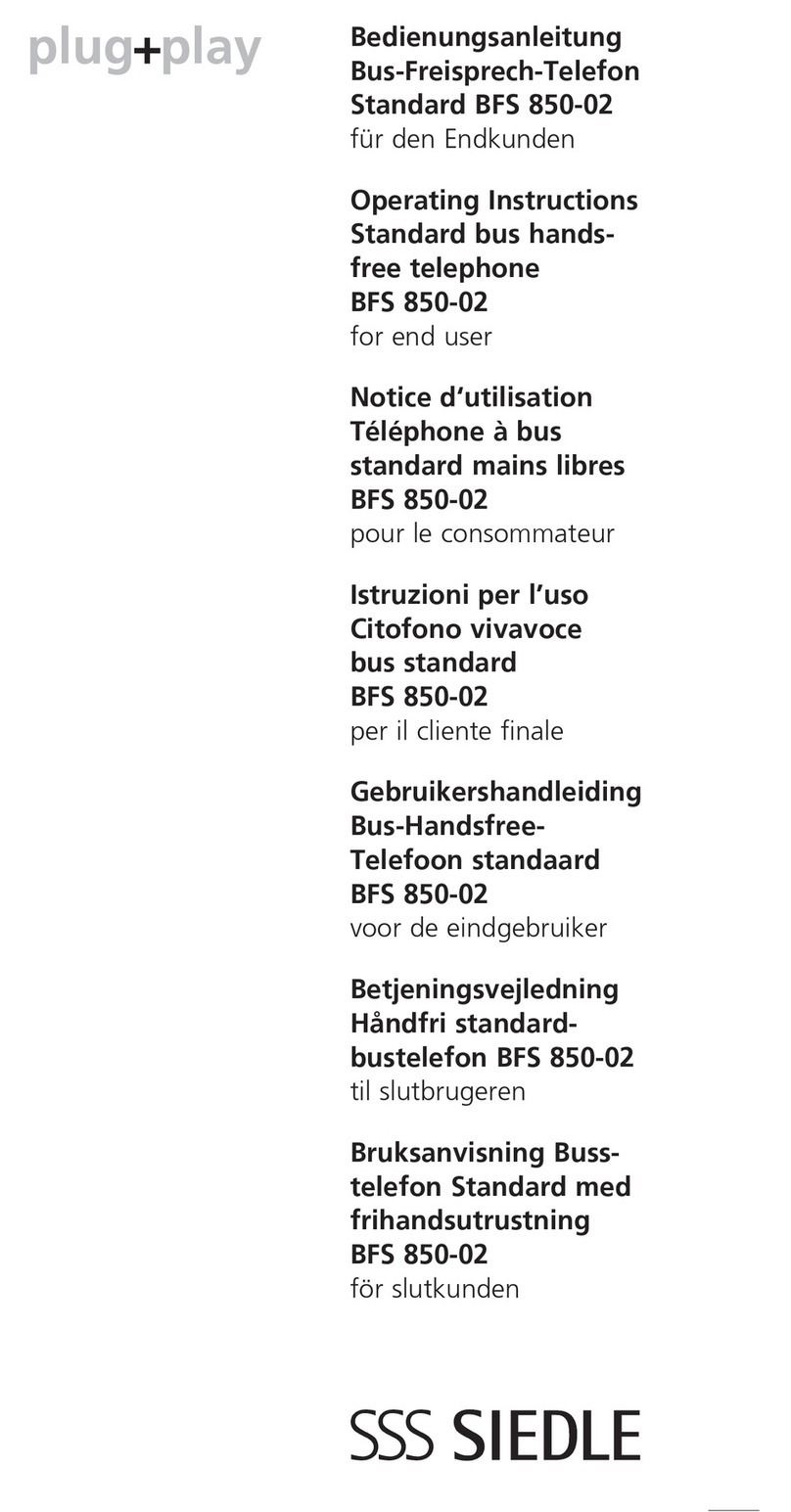
Siedle
Siedle BFS 850-02 User manual
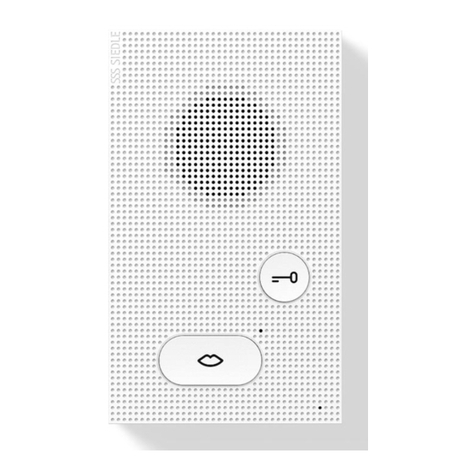
Siedle
Siedle AIB 150-0 User manual

Siedle
Siedle SET CVSG 850-1 User manual
